 | ||
Schedule ListBimonthly: #105-113; #217-232Eight times a year: #114-157; #212-216; #233-256Nine times a year: #158-211Monthly: #257-350 Publication date List(vol. 1)February–March 1959 - October 1985(vol. 2)June 1987–March 2006 and October 2007–February 2009(vol. 3)June 2010–July 2011(vol. 4)November 2011–July 2016(vol. 5)August 2016–Present Number of issues List(vol. 1)246 and 1 Annual(vol. 2)249 (#1-247 plus issues numbered 0 and 1,000,000) and 13 Annuals(vol. 3)12(vol. 4)56 (#1-52 plus issues numbered 0, 23.1 through 23.3) and 4 Annuals(vol. 5)9 (as of December 2016 cover date Main character(s) (vol. 1, 3, 4, and 5)Flash (Barry Allen)(vol. 2)Flash (Wally West) Writer(s) List(vol. 1):John BroomeGardner FoxFrank RobbinsCary BatesSteve GerberRobert KanigherMartin Pasko(vol. 2)Mike BaronGeoff JohnsWilliam Messner-LoebsMark Waid(vol. 3)Geoff Johns(vol. 4)Francis ManapulRobert VendittiBrian BuccellatoVan Jensen(vol. 5)Joshua Williamson Similar The Flash: Rebirth, All‑Flash, Green Lantern, 52, DC Rebirth | ||
The Flash is an ongoing American comic book series featuring the DC Comics superhero of the same name. The character's first incarnation, Jay Garrick, first appeared in Flash Comics #1. When the Silver Age Flash (Barry Allen) was introduced, that character took over Flash Comics numbering and the series was retitled as The Flash.
Contents
- Volume 1 19591985
- Volume 2 19872006 20072008
- Volume 3 20102011
- Volume 4 20112016
- Volume 5 2016present
- The Flash vol 1
- The Flash vol 2
- The Flash vol 3
- The Flash vol 4 The New 52
- The Flash vol 5 Rebirth
- References
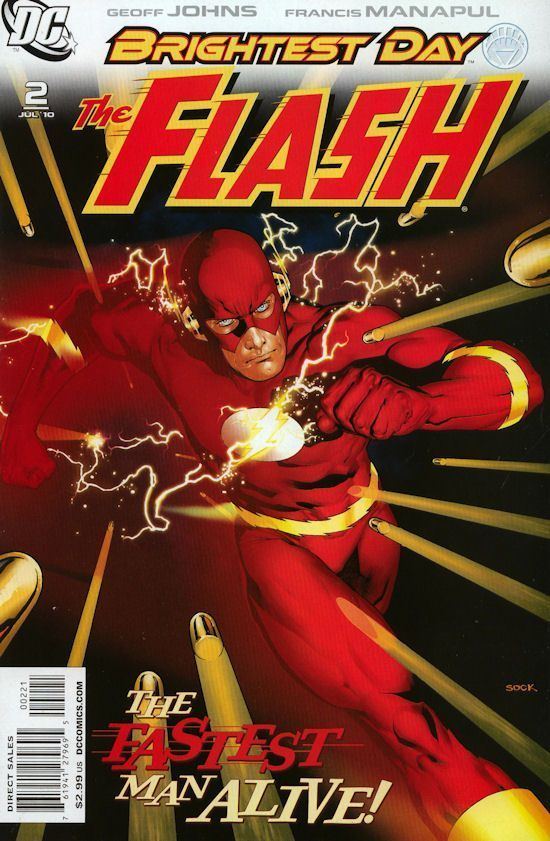
Although the Flash is a mainstay in the DC Comics stable, the series has been canceled and rebooted eight times. The first series featuring Barry Allen was canceled at issue #350 in the event of the character's death in the universe altering event Crisis on Infinite Earths. When Wally West succeeded Allen as the Flash, a new series began with new numbering in June 1987. That series was briefly canceled in 2006 in the wake of the Infinite Crisis event, but was restarted with its original numbering in 2007, only to be canceled again in 2008 in the wake of Barry Allen's return in Final Crisis and The Flash: Rebirth. The series was revived for a third volume by writer Geoff Johns and artist Francis Manapul after the completion of the Blackest Night event in 2010. A fourth volume was launched in 2011 as part of The New 52. A fifth volume was launched in 2016 as part of DC Rebirth.
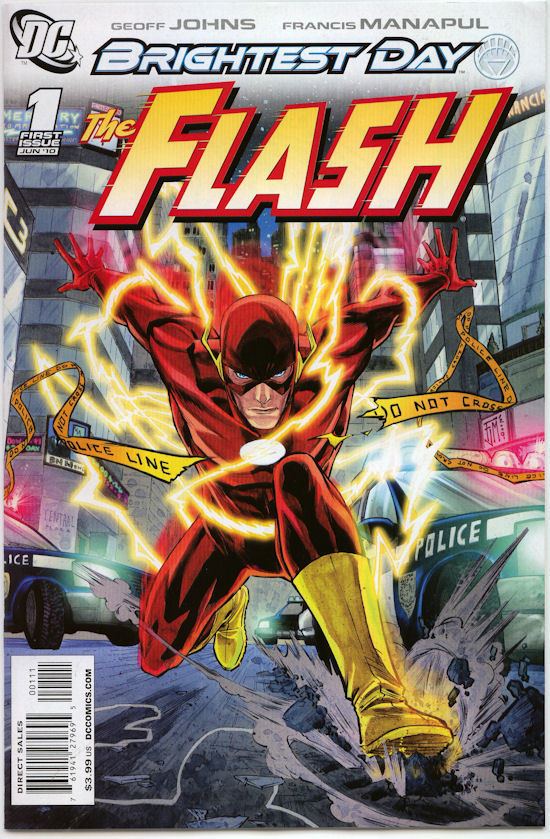
Volume 1 (1959–1985)
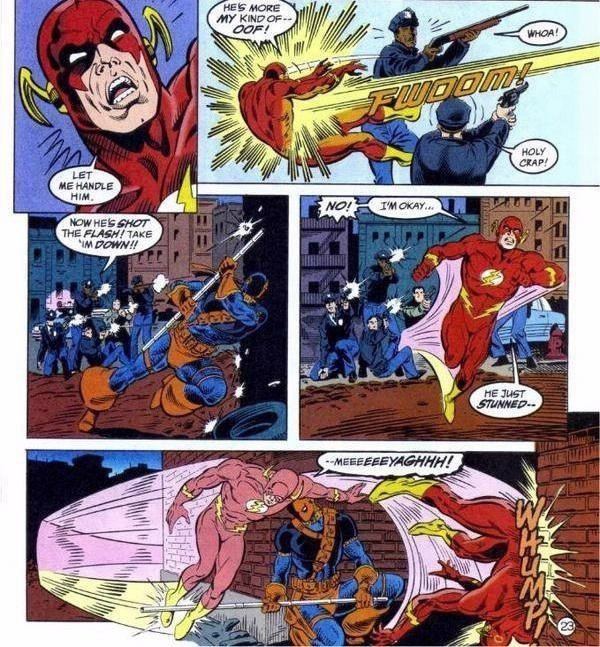
Volume 1 starred Barry Allen as the Flash and the series assumed the numbering of the original Flash Comics with issue #105 (March 1959) written by John Broome and drawn by Carmine Infantino. Comics historian Les Daniels noted that "The Flash" was a streamlined, modernized version of much that had gone before, but done with such care and flair that the character seemed new to a new generation of fans. The Broome and Infantino collaboration saw the introduction of several supervillains many of whom became part of the Rogues. The Mirror Master first appeared in issue #105 and the following issue saw the debuts of Gorilla Grodd and the Pied Piper. Captain Boomerang first challenged the Flash in issue #117 (December 1960) and the 64th century villain Abra Kadabra was introduced in issue #128 (May 1962). Another villain from the future, Professor Zoom first appeared in issue #139 (September 1963).
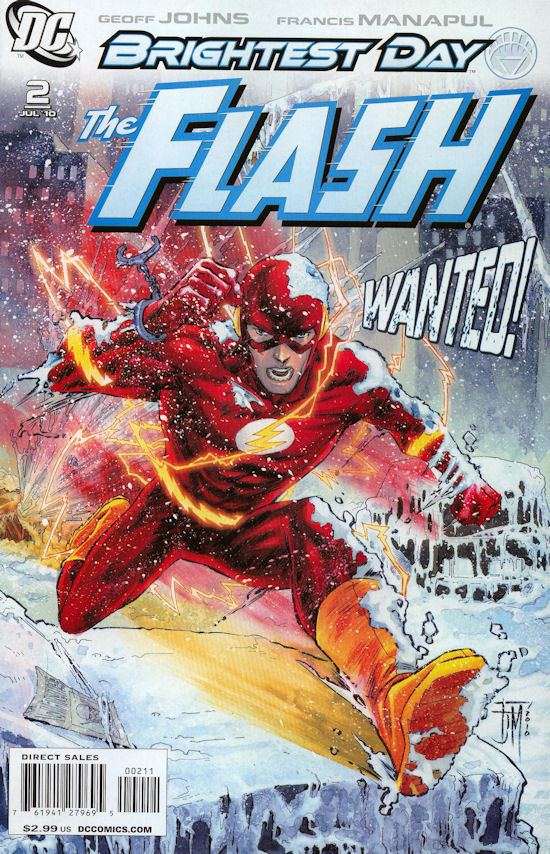
Kid Flash and the Elongated Man were respectively introduced in issues #110 and 112 as allies of the Flash. One of the most notable issues of this era was issue #123 (September 1961), which featured the story titled "Flash of Two Worlds". In it, Allen meets his inspiration Jay Garrick, after accidentally being transported to a parallel universe where Garrick existed. In this previous continuity, Garrick and the other characters of the Golden Age only existed as comics characters in the mainline shared universe. This brought about a new concept in the formative stage of what would become the DC Universe, and gave birth to the current conceptualization featuring it as a multiverse.
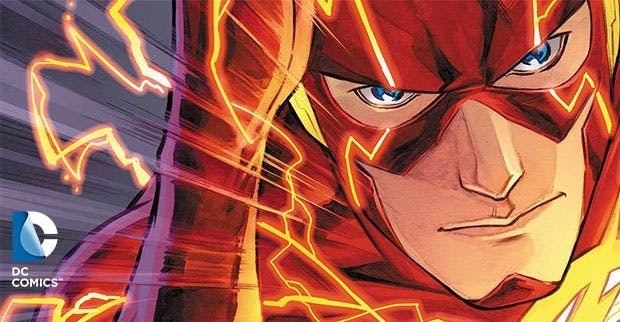
Barry Allen married his longtime love interest Iris West in issue #165 (November 1966). Infantino's last issue was #174 (November 1967) and the next issue saw Ross Andru become the new artist of the series as well as featuring the second race between the Flash and Superman, two characters known for their super-speed powers.
The series presented metafictional stories featuring comics creators appearing within the Flash's adventures such as the "Flash — Fact Or Fiction" in issue #179 in which the Flash finds himself on "Earth Prime". He contacts the "one man on Earth who might believe his fantastic story and give him the money he needs. The editor of that Flash comic mag !" Julius Schwartz helps the Flash build a cosmic treadmill so that he can return home. Several years later, the series' longtime writer Cary Bates wrote himself into the story in issue #228. Four months after the cancellation of his own title, Green Lantern began a backup feature in The Flash #217 (Aug.-Sept. 1972) and appeared in most issues through The Flash #246 (Jan. 1977) until his own solo series was revived. Schwartz, who had edited the title since 1959, left the series as of issue #269 (January 1979).

Bates wrote The Flash #275 (July 1979) wherein the title character's wife, Iris West Allen was killed. Don Heck became the artist of the series with issue #280 (Dec. 1979) and drew it until #295 (March 1981). The Flash #300 (Aug. 1981) was in the Dollar Comics format and featured a story by Bates and Infantino. Doctor Fate was featured in a series of back-up stories in The Flash from #306 (Feb. 1982) to #313 (Sept. 1982) written by Martin Pasko and Steve Gerber and drawn by Keith Giffen. A major shakeup occurred in the title in the mid-1980s. The Flash inadvertently kills his wife's murderer, the Reverse-Flash, in The Flash #324 (Aug. 1983). This led to an extended storyline titled "The Trial of the Flash" in which the hero must face the repercussions of his actions. Bates became the editor as well as the writer of The Flash title during this time and oversaw it until its cancellation in 1985. "The Trial of the Flash" was collected in a volume of the Showcase Presents series in 2011.
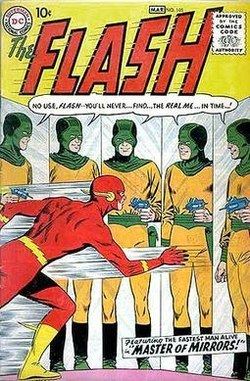
Shortly before Barry Allen's death in Crisis on Infinite Earths, the series was cancelled with issue #350 (October 1985). In the final issue of Crisis on Infinite Earths, Wally West, previously known as Allen's sidekick Kid Flash, stated his intent to take up his uncle's mantle as the Flash.
Volume 2 (1987–2006, 2007–2008)

Featuring Wally West as the main character, the Flash mostly operated out of Keystone City. The second series was launched by writer Mike Baron and artist Jackson Guice in June 1987. Featuring long runs most notably by writers Mark Waid and Geoff Johns, the second volume originally went in a different direction from the series starring Barry Allen by making Wally West more flawed. This Flash could not constantly maintain his super-speed because of his hypermetabolism, and would consume gargantuan amounts of food in order to continue operating at top speed. This metabolic limitation would later be continued into Barry Allen's character for the brief television series The Flash broadcast in 1990-91, as well as The Flash series which debuted in 2014, though to a lesser degree.
Mark Waid's tenure on the title in the 1990s brought back more traditional Flash aspects from Barry Allen's era by reforming the Rogues, some of which were new incarnations of old characters, and bringing more of a sci-fi/fantasy aspect that had been lost in Flash titles since Allen's departure. Waid made Wally West much more powerful in an attempt to take him out of Barry Allen and Jay Garrick's shadows. Waid and artist Mike Wieringo introduced Impulse in issue #92 (July 1994). Wally West married Linda Park in issue #142 (October 1998).
When writer Geoff Johns stepped aboard with issue #164 (September 2000), he refocused the character on some of the Silver Age aspects by spending single issues on building the psychology of the various Rogues. Johns created Zoom, the third of the Reverse-Flashes, and fleshed out the environmental character of Keystone City in an attempt to make it unique in comparison to other fictional DC cities such as Metropolis or Gotham City.
In the wake of the "One Year Later" event and Wally West's disappearance in Infinite Crisis, DC canceled The Flash vol. 2 with issue #230 (March 2006) in favor of a new series starring Bart Allen as the Flash. The new series, titled The Flash: The Fastest Man Alive, ran only 13 issues and ended with Bart's death. Mark Waid returned to the title briefly in 2007 with the series resuming with #231 to bring about the return of Wally West but the series was canceled again at issue #247 in late 2008 with the return of Barry Allen in the event series Final Crisis. Spinning out of Final Crisis, writer Geoff Johns and artist Ethan Van Sciver created The Flash: Rebirth, a 6-issue mini-series bringing Barry Allen back to a leading role in the DC Universe as the primary Flash. Barry Allen is also an integral character in the crossover event Blackest Night, and had a self-titled limited series tying into the main event.
Volume 3 (2010–2011)
In 2010, DC Comics announced that after the completion of The Flash: Rebirth and Blackest Night, Geoff Johns would return to writing a new Flash ongoing series with artist Francis Geracil. In January 2010, DC Comics announced that the series' opening arc would be launched under the banner of Brightest Day, a line-wide aftermath story to the crossover "Blackest Night". In April 2010, DC released The Flash: Secret Files and Origins 2010 one-shot, setting the stage for the status quo of the new series. It was followed one week later with the release of The Flash vol. 3 #1. On June 1, 2011, it was announced that all series taking place within the shared DC Universe would be either canceled or relaunched with new #1 issues, after a new continuity was created in the wake of the Flashpoint event. The Flash was no exception, and the first issue of the new series was released on September 2011.
Volume 4 (2011–2016)
DC Comics relaunched The Flash with issue #1 in September 2011, with writing and art handled by Francis Manapul and Brian Buccellato as part of DC's company-wide title relaunch, The New 52. As with all of the titles associated with the DC relaunch, Barry Allen appears to be about five years younger than the previous incarnation of the character. Superheroes at large have appeared only in the past five years, and are viewed with at best, suspicion, and at worst, outright hostility. In this new continuity, Barry's marriage to Iris West never took place, and he is instead in a relationship with longtime co-worker Patty Spivot. In this new series, the Flash draws deeper into the Speed Force, enhancing his mental abilities while still trying to get a full grasp on his powers, which he doesn't yet exert total control over.
As revealed in issue #0 of this series, Barry Allen's father was placed in prison for the murder of his mother. While the evidence seems to indicate his father's guilt, Barry makes proving his father's innocence a priority. The murder occurred shortly after Barry returned victorious from a school spelling bee, and Barry placed the trophy he won on his mother's grave in her memory. Barry is also part of the main cast of the relaunched Justice League series, making his debut in the series' second issue.
Writers Robert Venditti and Van Jensen and artist Brett Booth became the new creative team on The Flash as of issue #30 (June 2014).
Volume 5 (2016–present)
As part of the DC Rebirth relaunch, The Flash was restarted with a new series. The DC Universe: Rebirth Special returned the character Wally West as The Flash to the main continuity after being replaced following the Flashpoint limited series. In the New 52, Wally remained Iris West's nephew, but became an African American teen with no access to the Speed Force. In The Flash vol. 5 #1 (Aug. 2016), this Wally was retconned to being the son of a different brother of Iris West. The original Wally was revealed to be trapped in the Speed Force until he finally found Barry, who remembered him. The new series by writer Joshua Williamson and artist Carmine Di Giandomenico focuses on Barry dealing with unraveling the cause of this loss of 10 years with Wally, as well as taking on the new villain Godspeed. Meanwhile, Wally do the same in Titans issues. Both, Wally and Barry are called The Flash.
